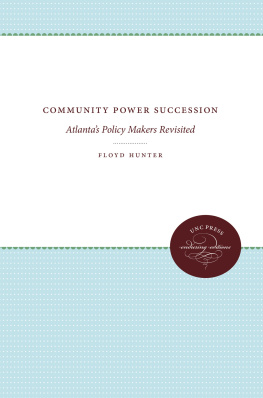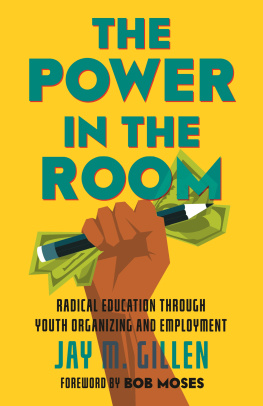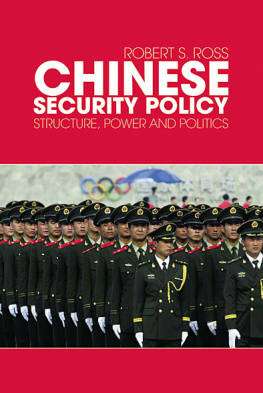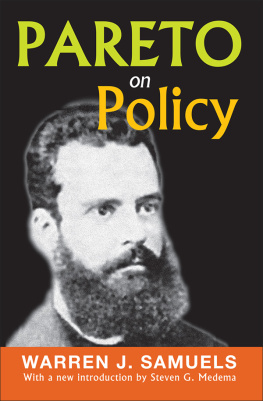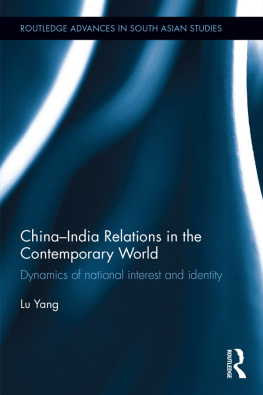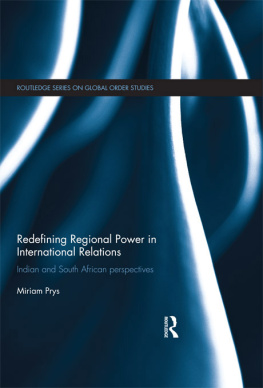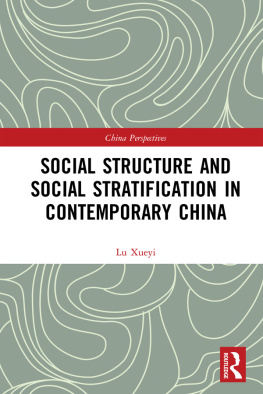COMMUNITY POWER STRUCTURE
1953 by The University of North Carolina Press
All rights reserved
Manufactured in the United States of America
ISBN 0-8078-0639-0 (alk. paper)
ISBN 0-8078-4033-5 (pbk: alk. paper)
Library of Congress Catalog Card Number 53-10042
94 93 92 91 90 10 9 8 7 6
THIS BOOK WAS DIGITALLY MANUFACTURED.
To
MY FAMILY
PREFACE
On occasion I have considered the possibility of re-studying the power structure of Regional City. Primarily because certain bits of information have indicated that the power structure in question has not very fundamentally changed its basic form or course in recent years, I have decided against such re-study.
Some of the evidence of the stability of Regional Citys power structure has come to me directly through observation and inquiry during brief visits there, through reading subsequent studies by others, and through releases in national publications and newscasts which have indicated that at least five of the ten top leaders I came to know around 1950 are still operating at their same locations. Mr. Homer, at the apex of power then, is still there. One of the top businessmen has become mayor, replacing another businessman mayor. A prominent banker is espousing a token paint-up, clean-up campaign in the slums. These men are working with the same police chief. Several expendable personnel in the civic machine, professionals like Joe Cratchett and Denny North, have come and gone. All continue to grapple ineffectively with problems of poverty and inequality of Afro-Americans, whom I earlier called Negroes. The Afro-Americans, in turn, are continuing to organize politically. Some have rioted. Others have enriched themselves just a little more, but not in anything like the amounts accumulated by their counterparts in the larger power scheme. The little fellows in the black community, like those in the white community, in lesser proportion and with lesser awareness of what is happening to them through credit and inflationary bondage and political hocus pocus, continue to come out on the short end of things. Thus, the structure would seem to have remained tight-knit, quite durable.
Further, in the context of recent history, I must say that some of my conjectures related to the desirabiity of integrating Afro-Americans into the power structure for more fruitful community development now seem naive. It would seem in 1968 that Regional City may experience wider black and white power separations and ensuing negotiations stemming from greater power equality before any meaningful integrations of power processes may come into being.
Like any published work that is subjected to extensive scholarly criticism, positive and negative, this one has taken on a life of its own. Certainly, it has put the term power structure into the language, on the streets as well as in the media. Its relatively simple methods of study have been widely used by others. It has become a classical text in social science classes. It has enjoyed, without publicity, a steadily expanding group of readers (to whom it has been useful) outside the universities.
While some of the conclusions drawn from it by scholars and the uses to which the book has been put by active politicians often surprise me, it has never seemed to be correct that I should attempt to answer the critics or users of the book. It must speak for itself. I am grateful that it has spoken to so many.
Of the many who have found the book politically useful, I like to quote Charles R. Sims, President of the Deacons for Defense and Justice, Bogalusa, Louisiana. Mr. Sims had been asked by a reporter what difference his defense organization may have made in local power relations. He replied: Well, when the white power structure found out that [the Deacons] had mens, Negro mens that had made up their minds to stand up for their people and give no ground, would not tolerate no more police brutality, it had a tendency to keep the night-riders out of the neighborhood.
Recognizing the correctness of Mr. Simss understanding of power relationships, one may know that the message of Community Power Structure has arrived at an important destination.
FLOYD HUNTER
El Cerrito, California
June, 1968
Contents
Tables
1 Number of Persons Under Direct Administrative Control of Leaders in Regional City, 1950-51
2 Regional City Leaders Ranked According to Number of Votes Received from Other Leaders in Leadership Poll
3 Leadership as Determined by Numbers of Mutual Choices Among 40 Power Leaders
4 Policy-Making Leaders in Regional City by Occupational Position
5 Sub-Community Leaders Ranked According to Number of Votes Received from Other Negro Leaders in Leadership Poll
6 Sub-Community Leadership by Numbers of Mutual Choices Between Leaders
7 Negro Organizations Receiving the Highest Number of Votes in Sub-Community Leadership Poll
8 Major Issues or Projects Reported by 26 Top Leaders as Before the Community of Regional City, 1950-1951
9 Major Issues or Projects Reported by 14 Professionals as Before the Community of Regional City, 1950-1951
10 Major Issues or Projects Reported by 22 Sub-Community Leaders as Before the Community of Regional City, 1950-1951
Figures
1 Residential Areas Occupied by Policy-Makers and Professional Personnel
2 Mutual Choices Made by Leaders in Regional City Leadership Poll
3 Mutual Choices of 27 Leaders in Regional City Leadership Poll
4 All Choices of Upper-Limits Group of 12 Leaders in Leadership Poll
5 All Choices of Lower-Limits Group of 15 Leaders in Leadership Poll
6 Interlocking Directorates of Corporate Leaders in Regional City
7 Interlocking Club Memberships of 24 Regional City Leaders
8 Generalized Pattern of Policy Committee Formation Utilizing Institutional and Associational Structures
9 Pattern of Participation of Three Strata of Institutional and Associational Personnel in Policy Formulation of Regional Citys Plan of Development
10 Pattern of Participation of Three Strata of Institutional and Associational Personnel in Activating Program of Regional Citys Plan of Development
11 Mutual Choices of 23 Leaders in Sub-Community Leadership Poll
12 All Choices of 9 Upper-Limits Group of Sub-Community Leaders in Leadership Poll
13 All Choices of 14 Lower-Limits Group of Sub-Community Leaders in Leadership Poll
14 Residential Areas Occupied by 31 Sub-Community Leaders
15 Non-Political Leaders of the Larger Community with Whom Sub-Community Leaders Have Worked
16 Upper-Limits Political Leaders from the Larger Community with Whom Sub-Community Leaders Have Worked
17 Relation of Sub-Community Citizens to Policy-Making Structure in Regional City
COMMUNITY POWER STRUCTURE
1 INTRODUCTION
It has been evident to the writer for some years that policies on vital matters affecting community life seem to appear suddenly. They are acted upon, but with no precise knowledge on the part of the majority of citizens as to how these policies originated or by whom they are really sponsored. Much is done, but much is left undone. Some of the things done appear to be manipulated to the advantage of relatively few.


